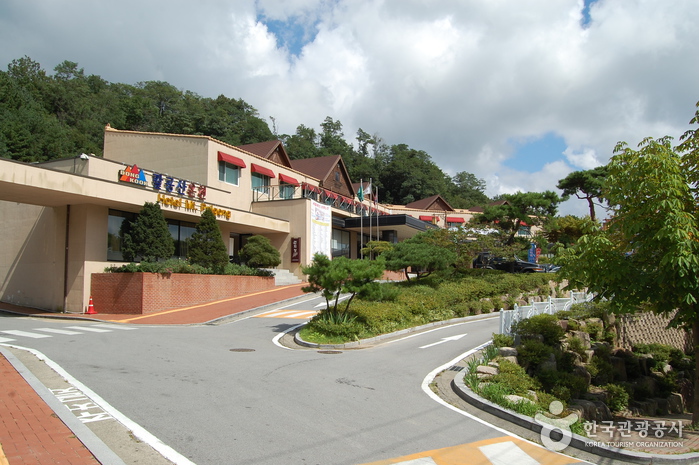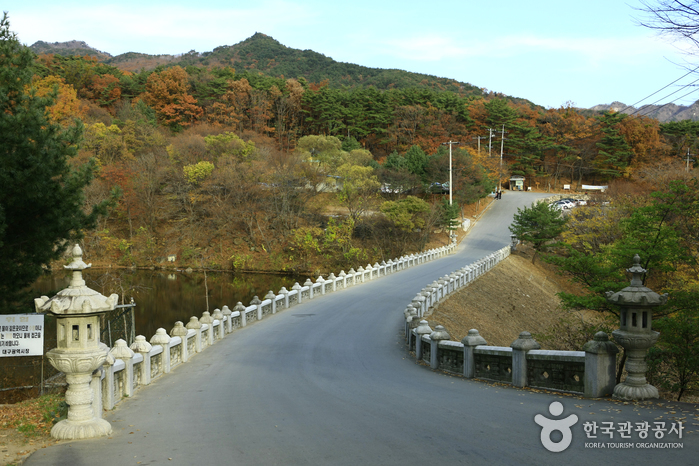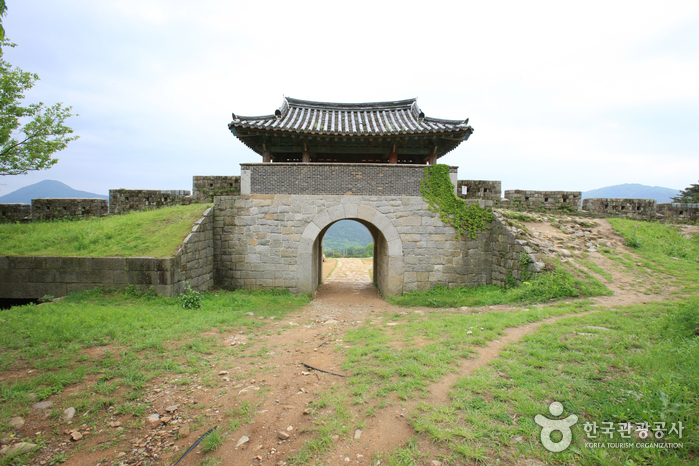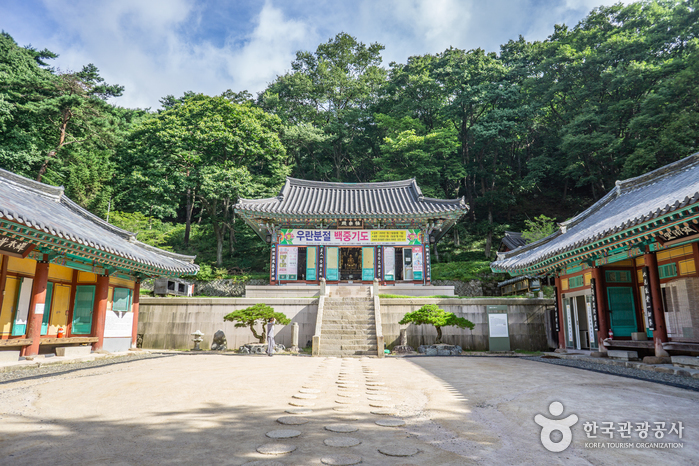Sanchae Restaurant (산채식당)
16.6Km 2024-02-28
72, Palgongsan-ro 185-gil, Dong-gu, Daegu
053-985-4082
Sanchae Restaurant is a wild vegetable Korean restaurant situated at the entrance of Palgongsan Cable Car. Since its opening in 1995, the restaurant has passed onto its second generation, maintaining the authentic flavors that have defined its success. With a commitment to recreating traditional homemade meals, Sanchae Restaurant uses self-cultivated vegetables, perilla seeds, garlic, chili pepper powder, and homemade fermented condiments. Among its signature dishes, the sannamul bibimbap (wild vegetable bibimbap) stands out, showcasing a delightful blend of seven namuls (salad) seasoned with a savory soy sauce.
Mt. Palgong Hot Spring Tourist Hotel (팔공산온천관광호텔(온천))
16.8Km 2024-02-28
11 Palgongsan-ro 185-gil, Dong-gu, Daegu
Mt. Palgong Hot Spring Tourist Hotel is nestled near Birobong Peak of Palgongsan Mountain. It features a hot spring bath with sodium chloride alkaline water (pH 8.0), sourced from 687 meters below the granite surface of a nearby valley. The spring water, at a temperature of 28.9 ℃, is renowned for its properties that soothe the skin, enhance blood circulation, and relieve fatigue. The facility includes hot and cold baths, jet benches for water massages, a sauna, and open-air baths. Additionally, the surrounding Palgongsan Mountain area boasts numerous tourist attractions, including Donghwasa Temple, a cable car, and various hiking trails.
Nokdongseowon Confucian Academy (녹동서원)
16.8Km 2024-02-06
218 Urok-gil, Gachang-myeon, Dalseong-gun, Daegu
+82-53-659-4490
Nokdongseowon Confucian Academy was built in 1789 in honor of General Kim Chung-seon (1571-1642), who contributed greatly to Korea's defense during the Imjin War (1592-1598). The academy was shut down in 1868, and reinstated in 1885. Then, in 1971, it was moved to its current location. Today, General Kim's tablet is enshrined in this hall, where a memorial service is held every March. Nearby attractions on the grounds of Nokdongseowon include Nokdongsa Temple, Sunguidang Shrine, Hyangyangmun Gate and memorial stones.
Dalseong Korea-Japan Friendship Center (달성 한일우호관)
16.8Km 2022-12-29
206, Urok-gil, Dalseong-gun, Daegu
+82-53-659-4490
The Dalseong Korea-Japan Friendship Center opened in 2012 to highlight the philanthropy of General Kim Chung-seon (Japanese name Sayaka, 1571-1642) and promote friendship between Korea and Japan. Kim Chung-seon was a Japanese general who defected to Korea during the Imjin War. Shortly after arriving on Korean soil as a commander of a Japanese army, Kim, together with his soldiers, defected to Korea, a choice that has been traditionally attributed to his respect for Korean culture. He transferred the technology of manufacturing rifles to the Korean army and contributed greatly in battles in Gyeongju and Ulsan.
A great number of tourists visit the center to learn about history, including students and their parents, as well as numerous Japanese tourists who visit to commemorate the spirit of General Kim. The center features exhibition rooms, a 3D theater, a tea ceremony room, relics, manifestations of traditional games in Korea and Japan, documents from Wakayama prefecture in Japan, and a site for experiencing archery, all of which can be utilized free of charge.
Palgongsan National Park (Donghwasa Temple District) (팔공산국립공원(동화사지구))
16.9Km 2025-08-11
1 Donghwasa 1-gil, Dong-gu, Daegu
Palgongsan National Park is located close to Palgongsan Mountain, one of the larger mountains in the Taebaek Mountain Range. Palgongsan Mountain is located 20 kilometers northeast from downtown Daegu, where the Nakdonggang and Geumhogang Rivers meet. The mountain has three peaks in a row: Birobong Peak (1192.3 meters) in the center and Dongbong (aka ‘Mitabong,’ 1,155 meters) and Seobong (aka ‘Samseongbong,’ 1,150 meters) on each side.
The park is within the administrative district of Dong-gu, with Daegu and four towns along its border, including Yeongcheon-si, Gyeongsan-si, and Chilgok-gun. A number of Buddhist temples including Donghwasa, the headquarters of the 9th Buddhist Parish, are located in the area.
The park has numerous rocks and valleys and is carpeted with azaleas in the spring. In the autumn many visitors flock to the park to admire the fall leaves on the trees lining the 16.3-kilometer-long roadway that runs through the park. With vibrant green leaves in spring and a delicate snowscape in the winter, Palgongsan Mountain is an attractive destination for visitors throughout the year.
Palgongsan Nature Park (Gatbawi District) (팔공산자연공원(갓바위지구))
16.9Km 2024-02-29
6-1 Palgongsan-ro 199-gil, Dong-gu, Daegu
+82-53-939-0080
Palgongsan Nature Park, located in the Taebaek Mountain Range, features three peaks: Birobong Peak (1,192m), Yeombulbong Peak (1,042m), and Seobong Peak (1,150m). This mountain area boasts stunning rock formations and valleys. At an elevation of 852 meters on Gwanbong Peak, the Gatbawi Rock is renowned for fulfilling wishes. Other attractions include Donghwasa Temple, the Palgongsan Cable Car, and the Donghwasa Tourist Complex.
Palgongsan Cable Car (팔공산 케이블카)
16.9Km 2025-08-12
51 Palgongsan-ro 185-gil, Dong-gu, Daegu
Palgongsan Cable Car takes visitors a ride on an ascending slope, offering both thrill and beautiful views. The cable car's landing platform is at the top of Sinnimbong Peak of Palgongsan Mountain. This peak is considered one of the most famous prayer spots, together with the ritual alter on Birobong Peak and the Buddha statue on the eastern Gatbawi Rock.
Daegu Donghwasa Temple (동화사(대구))
17.3Km 2025-08-11
1 Donghwasa 1-gil, Dong-gu, Daegu
Donghwasa Temple is located on the south side of Palgongsan Mountain, about 22 km northeast of Daegu. It was built by Monk Geukdal in the 15th year of King Soji’s reign (AD 493). The original name of the temple was Yugasa Temple, but Simjiwangsa rebuilt the temple under King Heungdeok (r. AD 826-836) and named it Donghwasa Temple, which means "the paulownia tree blooms even in winter," in reference to the blooming trees around the temple. Most of the present temple buildings were constructed between 1723 and 1732.
Chilgok Gasansanseong Fortress and Gasanbawi Rock (칠곡 가산산성 및 가산바위)
19.0Km 2025-01-08
Gasan-ri, Chilgok-gun, Gyeongsangbuk-do
+82-54-979-6452
Gasansanseong Fortress in Chilgok-gun, Gyeongsangbuk-do is located in the middle of Chilgok-gun, between Daegu Metropolitan City and Gumi. Gasansan Mountain (901m in elevation) is 10 kilometers west of Palgongsan Mountain. Because it boasts seven peaks, the mountain was called Chilbongsan Mountain. After enduring foreign invasions, including the Imjin War (1592-1598) and the Qing invasion of Joseon (1636), the Joseon rulers built a fortress over the course of 100 years to aid in Korea’s defense. It is Korea’s only three-layered fortress, consisting of inner, outer and central walls. The flat Gasanbawi Rock at the mountain’s peak, which is large enough to accommodate 100 people at a time, offers a great view of Daegu Metropolitan City.
Gyeongsan Seonbonsa Temple (선본사(경산))
19.2Km 2021-12-02
699, Gatbawi-ro, Gyeongsan-si, Gyeongsangbuk-do
+82-53-851-1868
Seonbonsa Temple is a centrally administered temple of the Jogye Order. It was originally built in 491 by Geukdal, and later repaired in 1641. The temple is home to many important cultural treasures, including the Stone Seated Buddha at Gwanbong Peak (Treasure), Three-story Stone Pagoda (Gyeongsangbuk-do Cultural Heritage), and stone lanterns.





 English
English
 한국어
한국어 日本語
日本語 中文(简体)
中文(简体) Deutsch
Deutsch Français
Français Español
Español Русский
Русский